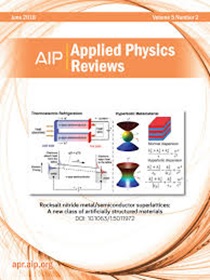Progress and perspectives on polycrystalline germanium thin films: Advances in solid-phase crystallization
IF 11.6
1区 物理与天体物理
Q1 PHYSICS, APPLIED
引用次数: 0
Abstract
Polycrystalline germanium (Ge) thin films have reemerged as promising materials for next-generation electronic and optoelectronic devices because of their superior electrical and optical properties. However, challenges such as high defect densities, small grain sizes, and unstable n-type conduction have limited their practical application. In this paper, we review the progress in the solid-phase crystallization of Ge thin films on insulating substrates. We first discuss conventional processes with excessive nucleation that lead to poor crystallinity and electrical properties. We then introduce advanced solid-phase crystallization strategies, highlighting the critical role of controlling the amorphous deposition temperature to control atomic density, increase grain size, and reduce acceptor defects. Additionally, the incorporation of tin (Sn) has been shown to passivate grain boundaries, while the modulation of film thickness and the introduction of interfacial layers have demonstrated the ability to mitigate carrier scattering at the substrate interface. This review also addresses impurity doping techniques for precise Fermi level control, strain engineering effects on grain boundary barrier energies, and metal-induced lateral crystallization for grain alignment. These innovations have culminated in achieving record-high carrier mobilities of 690 cm2 V−1 s−1 for p-type and 450 cm2 V−1 s−1 for n-type films, approaching single-crystal performance. The insights provided herein will pave the way for the development of high-performance Ge-based thin-film transistors and flexible electronic devices via low-temperature processing.多晶锗薄膜研究进展与展望:固相结晶研究进展
多晶锗(Ge)薄膜因其优异的电学和光学性能而重新成为下一代电子和光电子器件的重要材料。然而,诸如高缺陷密度、小晶粒尺寸和不稳定的n型导电等挑战限制了它们的实际应用。本文综述了绝缘衬底上锗薄膜固相结晶的研究进展。我们首先讨论常规工艺与过度成核,导致结晶度和电性能差。然后,我们介绍了先进的固相结晶策略,强调了控制非晶沉积温度在控制原子密度、增加晶粒尺寸和减少受体缺陷方面的关键作用。此外,锡(Sn)的掺入已被证明可以钝化晶界,而薄膜厚度的调制和界面层的引入已被证明能够减轻衬底界面处的载流子散射。本文还讨论了用于精确费米能级控制的杂质掺杂技术,对晶界势垒能的应变工程影响,以及金属诱导的晶粒取向横向结晶。这些创新最终实现了创纪录的高载流子迁移率,p型薄膜为690 cm2 V−1 s−1,n型薄膜为450 cm2 V−1 s−1,接近单晶性能。本文提供的见解将为通过低温加工开发高性能锗基薄膜晶体管和柔性电子器件铺平道路。
本文章由计算机程序翻译,如有差异,请以英文原文为准。
求助全文
约1分钟内获得全文
求助全文
来源期刊

Applied physics reviews
PHYSICS, APPLIED-
CiteScore
22.50
自引率
2.00%
发文量
113
审稿时长
2 months
期刊介绍:
Applied Physics Reviews (APR) is a journal featuring articles on critical topics in experimental or theoretical research in applied physics and applications of physics to other scientific and engineering branches. The publication includes two main types of articles:
Original Research: These articles report on high-quality, novel research studies that are of significant interest to the applied physics community.
Reviews: Review articles in APR can either be authoritative and comprehensive assessments of established areas of applied physics or short, timely reviews of recent advances in established fields or emerging areas of applied physics.
 求助内容:
求助内容: 应助结果提醒方式:
应助结果提醒方式:


